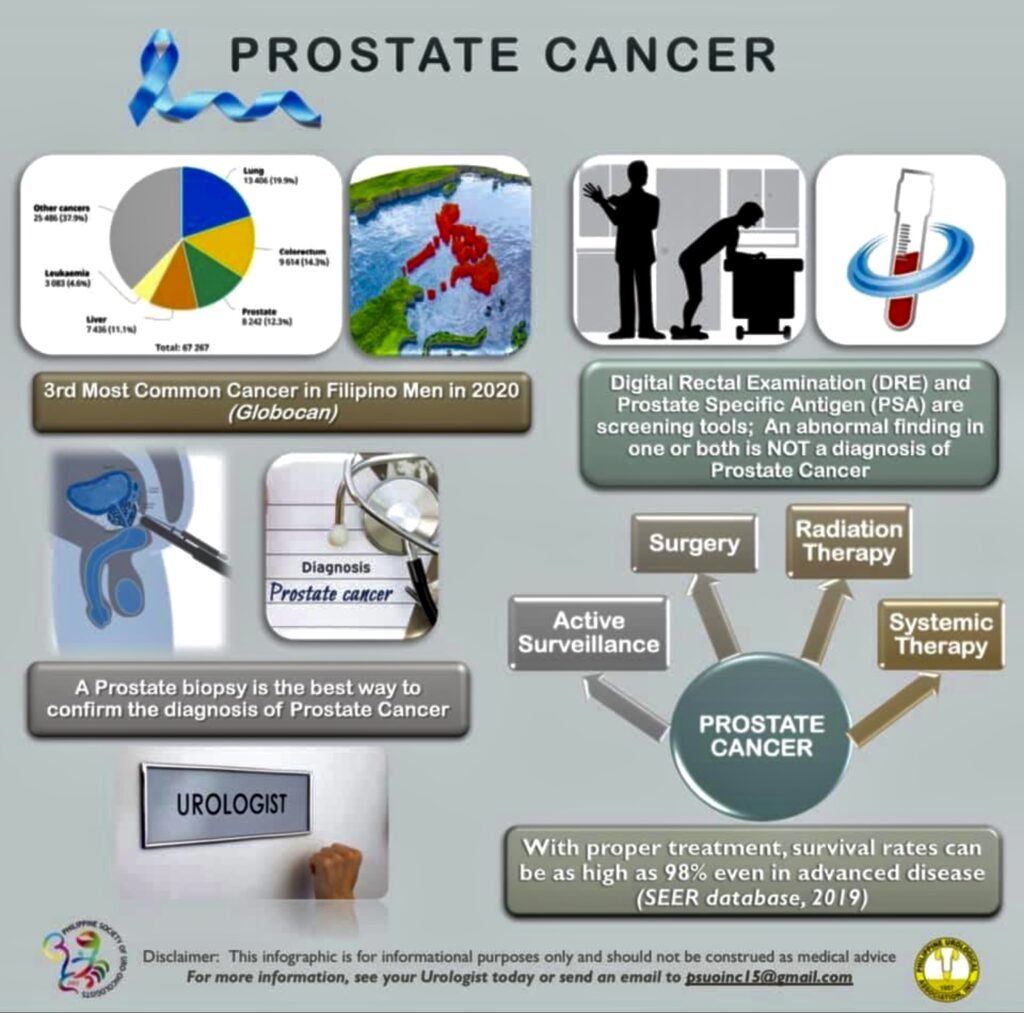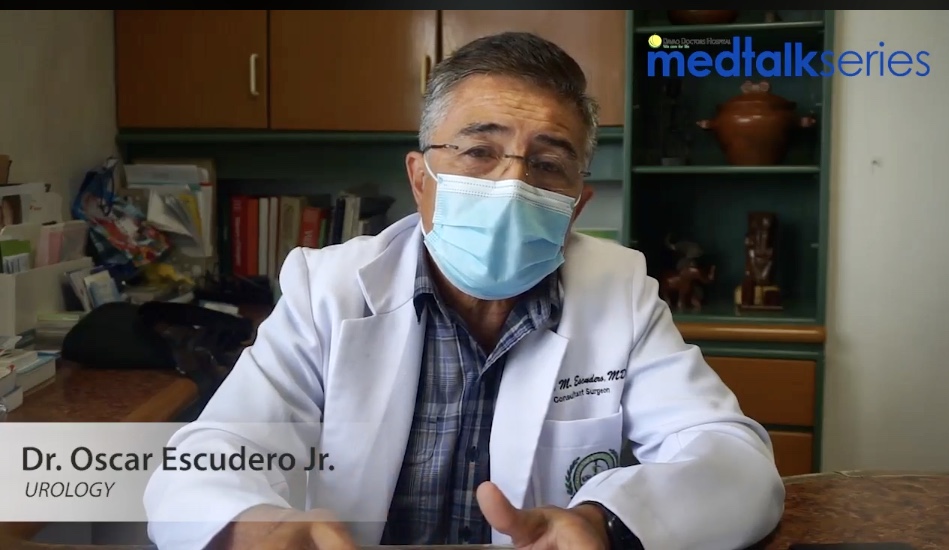Text by Henrylito D. Tacio
Photos and graphs from websites
Filipinos these days are more concerned about the coronavirus disease 2019 (COVID-10). So much so that they have neglected other diseases like prostate cancer.
Like other forms of cancer, prostate cancer is deadly. But like other forms of cancer, prostate cancer can still be cured when discovered early. If cancer has not spread to other parts of the body, there’s a likelihood that the complications can be minimized.
On a gloomy Monday morning, Dimuel Panes arrived at a private hospital in Davao City for a routine annual checkup required by his company. Feeling fine, and having always received a clean bill of health, the economics professor, then 45, had not wanted to take time off from work.
But this time, it was different. He noticed that his flow of urine has become a trickle. In some instances, he has to hang around the urinal before he is able to start. And to complete his embarrassment, he was apt to dribble on after he had hope to finish. As a result, he can no longer sit through a movie or even a dinner party without having to slip out to the comfort room.
At night, Dimuel was up every couple of hours, thus ruining both his sleep and that of his wife, Jean.
A nurse by profession, Jean knew that her husband’s father died of cancer. She thought that Dimuel might have inherited the disease. So, she urged him to undergo a blood test that measures levels of a protein called prostate-specific antigen (PSA). “You need this test,” she told him.
After weeks of prodding, Dimuel finally relented. After the test, the doctors detected that Dimuel’s PSA level was abnormal. A further biopsy revealed he has prostate cancer. The doctor suggested surgery.
Today, three years later, Dimuel is very much healthy and active. “The PSA test is the reason why I am still alive,” he admitted.
“Early detection,” says Dr. Willie T. Ong, an internist and cardiologist who serves as a consultant at the Manila Doctors Hospital and Makati Medical Center, “gives medicine its best window of opportunity for beating cancer.”
The need for early detection has never been greater. The Geneva-based World Health Organization (WHO) reports that dramatic increases in life expectancy, combined with profound changes in lifestyles, will lead to global epidemics of cancer.

Prostate cancer 101 
Dr Oscar Escudero
Third cause of death
Long considered a disease of the Western world – particularly North America and Europe – prostate cancer is also fast becoming a prevalent health burden in the Philippines. “It is common among men 60 to 70 years of age,” said Dr. Oscar Escudero, Jr., a urologist at the Davao Doctors Hospital.
In the Philippines, prostate cancer ranks as the third leading cancer site among men, said Dr. Escudero in the e-MedTalk series. Prostate cancer is behind lung, colorectal, and liver cancers.
“It is important for us to know what are the possible symptoms of prostate cancer and the possible preventive measures we can take,” he said.
This month of September, the country celebrates Prostate Cancer Awareness Month. The EEL Urology Group of Davao City, whose members are trained in urology at the National Kidney and Transplant Institute, is leading the awareness campaign.
“With proper treatment, survival rates can be as high as 98% even in advanced disease,” the group said based on data that is posted in its Facebook account.
In this time of the pandemic, older Filipino men should not only be cautious of the virus that causes COVID-19 but must also be aware of prostate cancer. “The number of prostate cancer cases in the Philippines continues to increase, leading health experts to believe that this silent killer will claim one life every hour,” wrote Francis Earl Cueto in a Manila Times feature.
Signs and symptoms
Like other forms of cancers, prostate cancer has some manifestations. “Generally, the signs and symptoms are related to urination,” Dr. Escudero said. These include the inability to urinate or difficulty starting or stopping the urine flow; the need to urinate frequently, especially at night; the weak or interrupted flow of urine; and pain or burning sensation during urination.
Other symptoms include difficulty having an erection or decrease in the amount of semen ejaculated; blood in the urine or semen; and frequent pain in the lower back, hips, or upper thighs. “If you have these symptoms, you better start consulting your urologist,” Dr. Escudero suggested.
The aforementioned are just signs and symptoms, and only a doctor can know for sure whether a man has prostate cancer.
“If you are suffering from any of these symptoms, go and see your doctor immediately so that the cause can be diagnosed and any relevant treatment administered,” recommends Professor Peter Lim Huat Chye, senior consultant and advisor of the Department of Urology at the Changi General Hospital in Singapore.
Understanding prostate
The prostate is a pili nut-sized gland located between the bladder and the penis. “The prostate is just in front of the rectum,” points out webMD.com. “The urethra runs through the center of the prostate, from the bladder to the penis, letting urine flow out of the body.
“The prostate secretes fluid that nourishes and protects sperm. During ejaculation, the prostate squeezes this fluid into the urethra, and it’s expelled with sperm as semen.” Its function, however, is regulated by testosterone, a male sex hormone produced mainly in the testicles.
On a case-by-case basis, doctors cannot pinpoint with certainty what causes prostate cancer. “The causes of prostate cancer are not well understood,” admits the US National Cancer Institute (NCI). “Doctors cannot explain why one man gets prostate cancer and another does not.”
Researchers are studying factors that may increase the risk of the disease. Having one or more closer relatives with prostate cancer increases a man’s risk of developing the disease. A diet high in animal fat is another factor (fats increase levels of testosterone).
Obesity is also a contributing factor. Two studies, which appeared in the Journal of Clinical Oncology, said that maintaining normal weight throughout your lifetime reduces your risk of developing prostate cancer.
Unlikely culprits
Those are some possible causes. There are those who believe that prostate cancer is caused by hitting the prostate area oftentimes; biking is a case in point. “Whatever sports you are in, those are not true. There is no scientific evidence or clinical association that biking can cause prostate cancer,” said Dr. Escudero, who has been biking for 35 years now.
There are others who associate prostate cancer with sex: oversex, under sex, or masturbation. Those are also myths, according to Dr. Escudero. In addition, no proven link exists between prostate cancer and the use of alcohol or tobacco, circumcision, infertility, and infection of the prostate. The theory that men who have vasectomies are at slightly increased risk for prostate cancer remains unproven.
“Compared with most other cancers, prostate cancer behaves rather strangely,” says The Medical Advisor: The Complete Guide to Alternative and Conventional Treatments.
Prostate cancer is the male equivalent of ovarian cancer in women. It’s a “silent killer,” a tumor that all too often goes undetected and spreads throughout the body. Usually, it grows slowly, taking years to progress.
“The problem,” says Dr. Jason L. Letran, urologist at the Cardinal Santos Medical Center and Chinese General Hospital, “is that often by the time a man notices something is wrong, he’s already missed his best chance for a complete cure.”
What men can do
Prostate cancer occurs mainly in older men. “About six cases in 10 are diagnosed in men aged 65 and older, and it is rare before age 40,” says the Philippine Cancer Society, Inc. (PCSI). “The average age at the time of diagnosis is about 66.”
Doctors, however, urges males who are 40 years old and above to undergo a digital rectal examination (DRE), in which a doctor’s gloved, lubricated finger is inserted into the man’s rectum to feel for lumps, enlargement, or areas of hardness that might indicate the presence of cancer.
“It is uncomfortable but not painful, and it’s generally brief, lasting less than a minute,” assures Professor Lim of DRE.
A serious drawback to DRE is that it cannot be totally relied upon. As such, Dr. Letran suggests a blood test that measures prostate-specific antigen (PSA), a protein given off by the prostate tissue. In general, the higher the PSA, the greater the risk of cancer.
Experts believe that the combination of DRE and PSA enhances early detection. From age 50 onwards, men are advised to get annual PSA and DRE tests. Males with a family history of prostate cancer should start getting annual checkups at age 40.
But in some instances, DRE and PSA are not enough. If the urologist finds something is wrong, he can recommend a transrectal ultrasound, a procedure involving the same technology that produces images of babies in the womb. While ultrasound can’t distinguish healthy cells from cancer cells, it can help direct a needle biopsy.
Available treatments
Unlike those in Western countries, most Filipino men with prostate cancer come for treatment very late when little can be done to help them. This is most unfortunate as the disease can be cured when detected early.
Prostate cancer treatment may seriously affect a man’s lifestyle, according to Dr. Letran. Major surgery, radiation therapy, and drugs for prostate cancer often cause impotence and may cause incontinence.
Treatment may also involve watchful waiting. “Watchful waiting is an option for men who are too old or too weak for treatment or for those who refuse treatment,” says Dr. Eduardo R. Gatchalian, past president of the Philippine Urological Association, Inc. “Yet for the relatively healthy elderly male, observation is not a viable option especially if we have a cancer that has a high Gleason score or the indicator of aggressive nature of the disease.”
Meanwhile, what are the chances of being cancer-free after getting diagnosed? There is a 100% chance of being declared cancer-free five years after treatment, according to Makati Medical Center (MakatiMed).
“The odds against prostate cancer have been steadily increasing over the years, making it a promising future,” says Dr. Jaime S.D. Songco, of MakatiMed’s Urologic Oncology Section, citing a 2017 study which showed that only about 4% of newly diagnosed prostate cancers spread to other organs. “Of course, early diagnosis is still key, as it further increases your chances of being declared cancer-free,” he added.
Death toll
If you are 50 or over, you better consider prostate cancer as a possibility. Film director Eddie Romero and architect Francisco “Bobby” Mañosa, both National Artists, have died of prostate cancer.
Romero, who was diagnosed with prostate cancer in 2012, lost his battle against the disease at the age of 88. “After the diagnosis, he took treatment very well,” his son, Joey, who is also a director, said in a Saksi interview.
It was not until April 2013 that the director’s health started deteriorating. This happened when he lost appetite to eat. “We had to put a tube in his stomach to help him be fed,” Joey was quoted as saying.
Romero died on May 28, 2013. Six years later, on February 19, 2019 – just eight days after his birthday – Mañosa also died of the same disease. The architect of some of the country’s iconic structures was also 88.
Other famous Filipino personalities who died of prostate cancer were singer Eugene Villaluz (70), film actor and television host Rod Navarro (67), movie actor Ross Rival (62), film actor Nestor de Villa (75).
